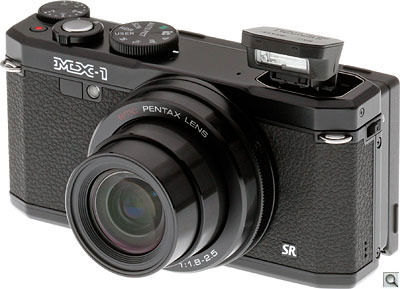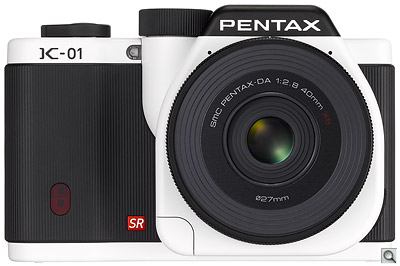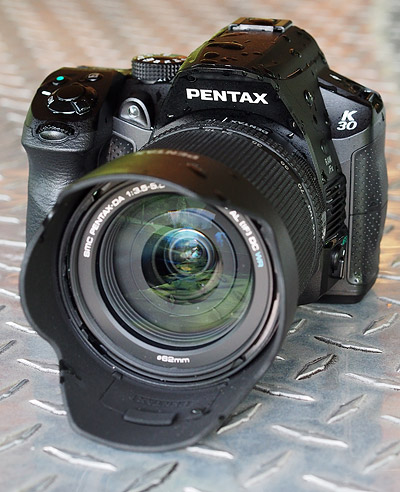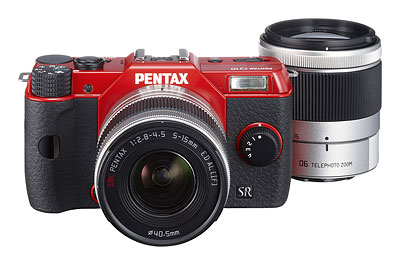Q&A with Pentax’s John Carlson: A deeper look inside the new MX-1, Pentax’s ILCs and lenses
posted Tuesday, January 15, 2013 at 9:32 PM EDT

Hot on the heels of the Pentax MX-1 announcement, Imaging Resource publisher Dave Etchells, managing editor Roger Slavens and director of development Arthur Etchells sat down with John Carlson, senior marketing manager at Pentax Ricoh Imaging to discuss the thinking behind the company's first enthusiast compact, why its latest-generation image processor didn't make it into the flagship K-5 II, and how photographers have taken to its first digital SLR that forgoes a low-pass filter in the hunt for maximum resolution.
Dave Etchells/Imaging Resource: It's been quite a year for Pentax. You've got a lot of new cameras and lenses which we saw at Photokina last September, and there are more announcements here. It's great to see that you're able to keep up the development pace. With more than a year having passed since you were acquired by Ricoh, are we now seeing the first fruits of Ricoh's backing starting to appear? Or were these products already on the drawing board before plans for the takeover began?
John Carlson/Pentax Ricoh Imaging: I think there's some minor Ricoh influence in the Pentax MX-1. But for the most part, there have been management changes with Pentax, and things that the end consumer doesn't necessarily see -- changes in how we do business, how we go to market, not necessarily the products themselves. I think you'll start to see Ricoh's influence in products more over the next year or so, as the two engineering teams are integrated and become one team.
DE: What can you tell us about potential collaborations, or sharing of features and technology between Ricoh and Pentax that you're most excited about? And has the design team that was responsible for cameras like the GR Digital series and the GXR been combined with your own?
JC: I believe the digital imaging engineering teams from both companies were combined a couple of months ago. And it's kind of exciting: we've got great features from Ricoh, a great user interface in the GR Digital for the more advanced photographer, and the heritage of Pentax's lens development and SLR bodies. Once they're fully integrated, everyone's working together, and we start seeing those products, I think there are definitely good things to come.
DE: Back in mid-2012, Pentax Ricoh Imaging president Noboru Akahane told the Asahi Shimbun newspaper that he had a goal of doubling combined camera sales for Pentax and Ricoh in 2013. Obviously the year's only just getting started, but how are things looking for that goal?
JC: Good. We've seen an increase in sales over the previous year, so we take that as a positive sign. Especially so when the largest part of the market -- the compact market -- is contracting, and we can still show growth. We take that as a step in the right direction.
DE: Yes, the rugged market is one of the few compact camera segments that is actually growing.
JC: Exactly. The high-end compact is growing, as well, and we now have an entry in that market -- or two entries now, the GR Digital IV and the MX-1.
DE: Speaking of the MX-1, that seems to be something of a departure for Pentax. It kind of harkens back to the film era, and you're picking up on that with the MX designation. What can you tell us about how that model came about, and does it mark a new direction on which we'll see a continued focus?
JC: I think it goes back to looking for where there are areas of strength within the market. Obviously the DSLR market is still growing, the compact system cameras are still growing, and then there are small segments of the compact market that are growing. We want to take advantage of that. We've dabbled in higher-end compacts in the past, going back to cameras like the Optio 750Z, which was a great camera. So we've done it before. I think what the engineers did with this camera is take our current imaging technology, the lens and sensor, and combine it with a classic look and construction. I saw a picture earlier today that someone showed me of our old ME -- which is very similar to the MX -- sitting right above the MX-1. They really looked at those old cameras when they were designing this camera, because the shape of the shoulder of the camera, the flat shape of the top of the camera is almost identical to some of our old classic film cameras. And then there's the materials themselves, with the brass covers.
DE: I know we've asked this before, but the question keeps coming from readers so I'll ask it again: full frame. Back in October, Japan's Impress DC Watch blog published an interview with Pentax Japan's development chief, Toshiyuki Kitazawa. He was quoted as saying that Pentax was working on a full-frame camera, and had definite plans for a product launch in 2013 or later. Given Kitazawa-san's statement, can you make any comments about Pentax's full-frame future?
JC: Only that Pentax has confirmed that yes, he made that statement, and it's an accurate statement. But as far as timing and specifications, we don't have any information to share at this point. It's an area we continue to study, and to look for a good solution.
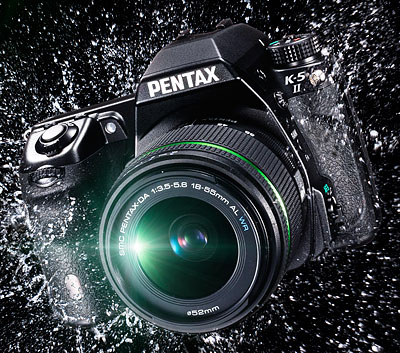
DE: Turning to current SLRs, the Pentax K-5 II seems to be a more incremental advance over its predecessor than the K-5 and K-7. Is the K-5 II something of an interim model until a new flagship can brought to market, or do you think it will remain your flagship APS-C model for a similar duration to that we saw with the K-7 and K-5?
JC: I would say it is an interim model, and you see that in the naming. Rather than a totally different number designation, we put the Roman numeral II, so it's the same body shape, a similar sensor -- just an updated version. But there are improvements also: the focusing system is significantly improved. As far as the lifespan of that product, it's difficult to say when a replacement will be coming along. But it's still a nice evolution of the product.
DE: You debuted a new SAFOX X autofocus module in the K-5 II, which improves low-light performance. The focus point layout and types seem to be the same as those in the SAFOX IX+, though. Can you tell us how the new AF module differs from its predecessor, and what allows it to focus better in low light?
JC: Some of it has to do with adjusting the firmware, and the autofocus sensor itself is a new design that reacts better in low-light conditions. The optic in front of the sensor -- the Fresnel lens -- is also higher quality, and this was improved in the Pentax K-30 as well. If you make that a higher quality, clearer optic, your results are going to be more accurate.
DE: Interesting. So the new autofocus module offers improvements beyond better low-light focusing, it's also more accurate?
JC: Yes, we're always improving the accuracy, but the main improvement is in low-light autofocusing.
DE: We've seen a lot of experimentation over the last year with on-sensor phase detect from a number of manufacturers. Can we expect to see Pentax making use of similar systems in future offerings, or is there a downside to these technologies that makes you hold off?
JC: There's not a particular downside that I'm aware of. Whether we'll use them or not, though, I can't really comment on that.
DE: Alongside the K-5 II, you debuted the K-5 IIs, a variant without the optical low pass filter. Is that something you've been hearing a lot of demand for, perhaps from nature and studio photographer where moiré is less of an issue?
JC: We looked at actual sales results from one of our competitors that offered a camera without the low-pass filter, and realized that there is a market for that product. What we have found since the K-5 II and the IIs were introduced is that we're actually seeing more success with the IIs model. There's a demand out there. If you look at the Pentax customer, and look at our Pentax Photo Gallery, the majority of those pictures are landscape, nature and wildlife photographs; the type of thing where moiré is less of a concern. [Editor note: Moiré effects appear most frequently when shooting man-made subjects with repeating patterns, as we saw in our Nikon D800E review.]
DE: And in creating that, did you actually remove the low-pass filter altogether? Or did you do what Nikon did, canceling out the effect by reversing one of the quarter-wave plates?
JC: We've asked Pentax Japan ourselves, but I haven't yet received confirmation one way or the other on that.
Arthur Etchells/Imaging Resource: Which do you think will have more appeal for DSLR owners looking for a second, smaller Pentax camera: the fixed-lens MX-1, or the Pentax Q10 mirrorless?
JC: It depends on their objective. No matter what level photographer you are, there's probably going to be a situation where you can't carry a larger camera. In my case, on our honeymoon my wife said "You're not going to carry that SLR around." So it's good to have a backup option, but it depends if the photographer's more comfortable with being limited to a camera with a fixed zoom, like the MX-1, or wants more options. While the Q system is extremely small, it's still an interchangeable lens system, but you've got to be able to carry around those extra lenses. A lot of it depends on shooting style, but I can guarantee there will always be opportunities where you can't or won't carry a DSLR and your full camera kit.
DE: We're interested that the K-5 II stayed with the PRIME II processor, rather than the PRIME M that's in the K-01 and the K-30. Was that a matter of cost, or would an updated processor have required that you also change a lot of other things internally?
JC: I think it's a little bit cost-related, and a little bit down to the engineering resources. We had great success with the quality of the images out of the PRIME II image processing engine. At the same time, the PRIME M engine that's in the K-30 wasn't capable of doing what we needed to with the output of the sensor in the K-5 II. If we had tried to bring the good qualities of both together, it would have led to a longer development time and potentially a higher cost.
DE: We've seen pretty significant differences in contrast detect autofocus performance, with the K-30 consistently outperforming the K-5. Will the K-5 II be able to catch up at all, or is the difference in speed due to the K-30's higher read rate from the sensor?
JC: It's that and the image processing engine itself; the difference between the PRIME II and the PRIME M.
DE: And as you said, you needed to stay with the PRIME II because of the read requirements of the sensor.
JC: Yes. The K-5 II has a 14-bit raw output, and the K-30 and K-01 were 12-bit.
DE: We were really impressed by the K-30; it offers a lot of camera for the money, with features that your competitors just don't offer at that price point: Weather-sealed body, pentaprism viewfinder, twin control dials. So how did you manage to do what the others couldn't? What's the secret to producing that camera at that price?
JC: It's a lot of know-how. For example, the weather sealing of the camera. We've been doing that on our SLRs all the way back to the K10D, so we have years of experience with that, and we've come up with the efficiencies to make it more cost effective. And then there's the decision to commit to things like the viewfinder. I mean, it is a better viewfinder. So if we make a little bit less money but can offer that added value, I think it was important to us. One thing I've learned is that the engineers at Pentax all seem to be photographers, appreciate those kinds of features themselves, and want to include them in the cameras.
DE: The K-30 also offers in-body AA battery support, which is very rare these days. Are you still hearing a lot of demand for that from users?
JC: It's kind of a mixed bag, and back when we had cameras that only took AA batteries, it was the same thing. There's a definite advantage to using a battery like a Lithium AA or an Eneloop, where you get significantly more shots per charge or per set of batteries than you will with a rechargeable, dedicated battery. So there are definitely benefits -- but do you want to keep buying new batteries, or recharging a set of four? There are pros and cons for both.
DE: When we spoke at Photokina last year, a reader posed an interesting question that we sadly didn't have time to ask. You've got an articulating LCD in the Pentax X-5, and going way back you had one in the Optio 750Z. Have you considered adding something similar to your SLRs, or is it too tough to provide weather-sealing with an articulated display?
JC: It's a combination of weather sealing and size. We've always been known for the compact nature of our SLRs. When you add that articulated screen, you're adding pretty significant size. So it's a two-part answer to that. Yes, part of it is the weather sealing, which is very important to our line, but it's also the size of the product.
DE: You have a very comprehensive offering in terms of all-weather shooting. Even more so now than ever, because all of your current SLR models are weather-sealed. You've got a healthy selection of weather-sealed lenses, and even a weather-sealed remote. But there's still one gap to be filled, which is the external flash. Is this something you're working on? Do you see enough demand for a new flagship strobe with weather sealing?
JC: I can't say whether we have any plans for a weather-sealed strobe, specifically, but we are displaying a concept model for a flash here at CES. That's a good indication that changes are coming to our flash lineup. What they will include, we'll have to see in the near future.
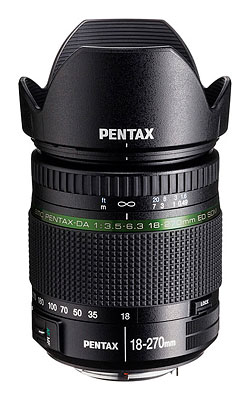
DE: We've been hoping to see a consumer-oriented, weather sealed lens reaching beyond 200mm. You've covered everything from 18-200mm with WR lenses, but to go beyond that, you've got to look to a DA * series lens -- either the 60-250mm f/4 or the 300mm f/4. Those are great for enthusiasts and pros, but we've heard some grumbling about the 18-270mm launching without weather sealing. Is it simply too much of a challenge to weather seal a lens with a 15x zoom range, and do you think we'll something in a longer lens coming?
JC: In a lens like our 18-270mm, when you're packing that much range into one lens, it's a larger lens anyway. Once you add weather sealing, it makes it even more so. And for that type of lens, there are some challenges with sealing so many moving parts. We definitely know that the demand is out there, though.
DE: We were wondering if it was simply down to the amount of air being moved around. Even lenses with a smaller range, like the 18-135mm, when you rack the zoom quickly there's a hurricane coming out the back of the lens.
JC: Exactly. And when you go the other way, it's sucking that air back in.
DE: As you've probably gathered, we're fans of Pentax SLRs for their unique mix of features -- great image quality, strong lenses, weatherproofing at lower price points, and fully featured SLRs that are as compact as some of your rival's entry level models. How do you get the message out about unique Pentax features, and are there particular use cases that you're targeting your advertising towards? And which other features do you think will help grow your market share?
JC: I think the internal directive for Pentax has been to start emphasizing those unique features more. You see that in our booth messaging here at CES, where we mention "unequaled." It's really focusing on those points. For the K-30, it's the weather sealing, the 100% field of view, that type of feature. For the K-5 IIs, it's the removal of the low-pass filter. For the Q, it's being the smallest camera system available on the market, and the fact that we now have 100 colors available. So it's really focusing the message on where we have an advantage, or are unique. We really want to do that because outside of that, there are a lot of similarities between the different camera manufacturers. You've got to look at the things that set you apart, and make sure consumers across the board understand those differences.
DE: We're a little bit curious about the overall shape of the Pentax lineup. It seems like we've lost the clear entry-level model. The K-x was a fantastic entry-level camera with a lot of features at a really affordable price. It's been almost three years since that launched. Can we expect to see another entry level model or do you see that space being filled by the mirrorless K-01 or Q10?
JC: That one's difficult to answer. I think there's room for both types of cameras, but there are no plans that I can comment on.
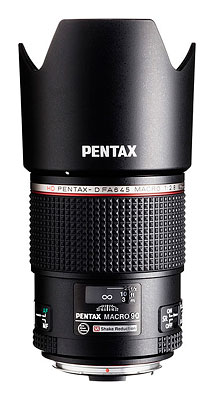
DE: Moving up to the larger cameras, the 645D. You announced the Pentax D FA 90mm f/2.8 Macro last year. It's pretty unique in that it's a medium format lens that has optical image stabilization in it. Can you say anything about challenges you faced, doing optical image stabilization with such a large image circle?
JC: Obviously, there are challenges there. With the Pentax 645D, it's such a big sensor that we had to come up with a different way to accomplish image stabilization outside the body, unlike the system we have in all of our DSLRs, so it's a matter of going to the lens. That may have lead to a larger lens physically, but for that market, the size was not out of control. Being compact is not as big of an issue for medium format, and in that realm, it's not that big of a lens. Pentax is dedicated to the 645 system and its mount, so hopefully we'll see more lenses along that line.
DE: That 90mm is also the debut of your new "High Definition" or HD branded lens coating. At Photokina in Germany, I saw the demo that showed just how much of an advancement that was over SMC (Super Multi Coating). Is that something that's going to be restricted to only the highest end lens models or is it something that you'll be able to deploy more broadly across the line?
JC: I think as we look at lens production, there's definitely the potential to employ that across the line. Maybe not in a kit lens or an entry-level lens, but I think there's definitely potential outside of 645 lenses.
DE: Might we see it even going down to an enthusiast pocket camera like the MX-1?
JC: That's difficult to say. There are so many opportunities, even with our sport optics products. I would love to get that coating into our binoculars, but it's a matter of... how do we accomplish that? Maintaining our goals obviously, the interchangeable lens cameras are to us the most important part of the line. So the focus will be there first, and then whether or not it expands beyond that, we'll have to see.
DE: You've got another coating, the "Aero Bright" coating, and it seems like both of those were used together in the 90mm. How do they differ? Are they serving different functions?
JC: The Aero Bright coating is for internal surfaces of the lens. It reduces internal reflections, and changes the refraction of the light through the lens. But it's not as durable as the HD coating, whereas the HD coating is appropriate for external lens surfaces. It's more durable, and it accomplishes the same goals. If you put them together, you end up with a great lens.
DE: Got it. I'm not sure what technology you're using, but I know that the nano coatings tend to be soft coatings, so they're very easily damaged.
JC: Yes.
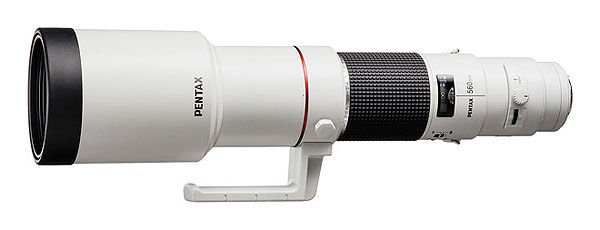
DE: The HD Pentax DA 560mm f/5.6 lens takes Pentax back to an area where you haven't had an offering for a while. Compared to your competitors, it's a good bit longer, but it's also pretty light, and has a smaller diameter barrel. Is that due to the telescope style optical design internally?
JC: Absolutely. In telescope-style design, all the optics are concentrated on the objective end of the lens, and at the mount -- what would be the eyepiece on a telescope -- with nothing in between, just air. If I remember correctly, there are also fewer optical elements needed, so the actual weight is reduced. It makes for a longer product, but also for a lighter-weight product. We made the compromise, and decided that's the way we wanted to go with that lens.
DE: And with a lot of the elements concentrated back at what would be the eyepiece on a telescope, they can have a smaller diameter, too. You don't need to have big hunks of glass back there.
JC: Exactly.
DE: The last time you had a lens with that kind of reach was around 2004, I think. What took you so long? [laughing] Was it that you didn't see enough demand, or was it just a matter of resources and priorities?
JC: Development resources, and looking at the target customer and our existing customer base to see what they're shooting, listening to their feedback. You know, it's an expensive lens, and to be honest the majority of our lenses are at a much lower price point than that one, not necessarily US$7,000 lenses, so we allocate our resources where the biggest demand is. And sometimes, it takes longer for certain lenses to come out based on that.
DE: Some of your competitors have lenses at similar focal lengths, but they're listing at price points above US$10,000. Now that you have a lens in that category, users are complaining about US$7,000. [laughing] What would you say to them?
JC: It's always a challenge. I'd love to drive a Porsche, but it's outside my means. The potential is there, though. If I'm dedicated to taking images that require that kind of lens, Pentax has it available, and we have it at a relatively affordable cost compared to the competition.
DE: You're the only manufacturer to offer two completely separate mirrorless lines with different lens mounts: the Q series, and the K-01. How do those buyers differ, and how do you cater to the needs of the two different groups?
JC: It's really interesting to look at the customers who bought the K-01 and the Q. There are some similarities, but there are lots of differences, too. The customer that bought the K-01 was very much design-oriented, and to a certain degree, were purchasing the camera due to the Marc Newson name associated with it. The Q system is more of an enthusiast camera that gives you better quality results than a smartphone, but is still extremely compact. So it really had a different appeal. There were some design-conscious people that were attracted to the Q, but it was more for the enthusiast that wanted something smaller, whereas the K-01 was definitely all about design.
DE: Which has proven more popular?
JC: The Q, definitely, and it's shown that Pentax is dedicated to that system. Several months ago, the original Pentax Q was one of the best selling cameras in Japan for that month. So especially in the Japanese market, there's a lot of interest in that system.
DE: Our last question is a really broad one: What do you see is the future for the camera market longer-term? What are the must have features that anybody who wants to stay on the game needs to have, and what technologies do you think are going to have the biggest impact on how we take photographs?
JC: I can't comment on specific technologies, but I think it's focusing on features and functions that a smartphone can't offer, or features and functions that complement that smartphone. If you take a camera like our MX-1, you can't get that fast of a lens or that size sensor in a smartphone. Or a camera like the Optio WG-2, the smartphone doesn't have that waterproof design, the zoom, and so on. And the same thing goes all the way up to the DSLR market, where it's all about image quality. The next step is how do you connect those cameras to your network of friends and family. So I think that's where there's a lot of potential.
DE: Great interview as always. Thank you for your time, and have a good show.
JC: Thanks!
